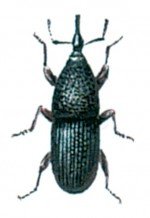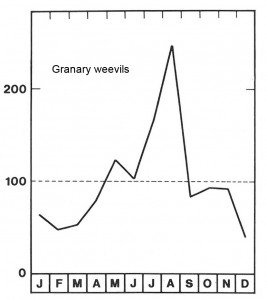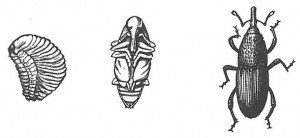

Latin: Sitophilus granarius.
The adult beetle is 2.5 to 5 mm long. The offspring is red-violet, and it later becomes brownish and old beetles are all black. It cannot fly. Its movements are quite slow and are somewhat similar to crayfish. In the winter cold storages, it is motionless and it becomes active when the temperature rises. The granary weevil does not live out in the open in Northern Europe. The weevils survive in warehouses where newly harvested grain is mixed with old, infested grain. The granary weevils live mainly in grains, and occasionally in hard baked goods such as dog biscuits and macaroni.
The female lays one egg at a time in a small crevice, which it has made in a kernel. When the egg is laid, the hole is covered with secretion, so it is no longer visible, and now it can only be detected by staining methods (page 156).
Inside the kernel the egg develops into a small larva, which quickly starts to hollow out the kernel. Once it has grown big, it pupates and finally it eats its way out of the shell as an adult weevil. Development time depends mainly on the temperature. At 12 ° C development lasts between 6 and 12 months. At 25 ° C development lasts a month. In Northern European grain storages the weevil usually produces two generations per year, but in warm cereal it can be expected to produce 5-6 annual generations. For each new generation there will be at least 15 times as many weevils as there were before. The weevils look quite peaceful, but for every beetle, you see, 20-40 larvae are devouring their own cores. A granary weevil infestation begins locally in a so-called “warm pocket”. It is often an external event, which starts this pocket. Water could have entered through a leak. Cereals could have been unable to get rid of the excess water due to dust accumulation. Humidity increases respiration and thus the temperature of the kernels. The heat and humidity attract female granary weevils. When many larvae develop in close proximity to each other, their metabolism cause the temperature and humidity to rise further, and at the same time there will be fungal growth in the centre of the pocket. In a more advanced stage, the inner warm pocket consists of kernels with dead, heat-killed granary weevil larvae in a dense mass of fungal hyphae, and the temperature can be up to 50 ° C. Around it there is a zone where lots of granary weevil eggs still hatch. As the pocket grows, fungal growth has taken over and the end result is a worthless block of sintered grains and a huge number of weevils.
It is believed that dust from the granary weevil-infested grain can be one of the causes of respiratory allergies to people who work with grain. The weevils cannot reproduce in grain stored at temperatures below 13 – 14 ° C, if there are no local warm pockets.

Extermination is best done with phosphoresced hydrogen gas when dealing with large quantities of grain. In small batches and in households, physical methods are often more convenient: Heating to at least 55 ° C for half an hour or a few days in the freezer will typically take care of the problem. To prevent weevils, empty warehouses and silos must be thoroughly cleaned and possibly also treated with a remedy for creeping insects before new grain is stored.




